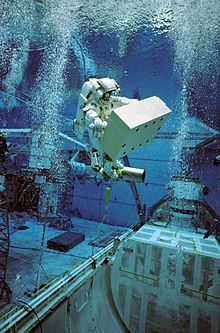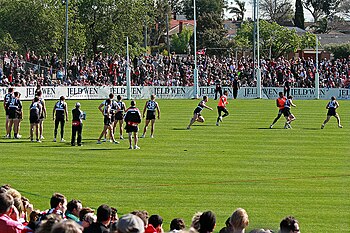This is an old revision of this page, as edited by Andycjp (talk | contribs) at 08:51, 23 June 2011 (→Religion and spirituality). The present address (URL) is a permanent link to this revision, which may differ significantly from the current revision.
Revision as of 08:51, 23 June 2011 by Andycjp (talk | contribs) (→Religion and spirituality)(diff) ← Previous revision | Latest revision (diff) | Newer revision → (diff) For other uses, see Training (disambiguation).
The term training refers to the acquisition of knowledge, skills, and competencies as a result of the teaching of vocational or practical skills and knowledge that relate to specific useful competencies. It forms the core of apprenticeships and provides the backbone of content at institutes of technology (also known as technical colleges or polytechnics). In addition to the basic training required for a trade, occupation or profession, observers of the labor-market recognize as of 2008 the need to continue training beyond initial qualifications: to maintain, upgrade and update skills throughout working life. People within many professions and occupations may refer to this sort of training as professional development.
Some commentators use a similar term for workplace learning to improve performance: "training and development". One can generally categorize such training as on-the-job or off-the-job:
- On-the-job training takes place in a normal working situation, using the actual tools, equipment, documents or materials that trainees will use when fully trained. On-the-job training has a general reputation as most effective for vocational work.
- Off-the-job training takes place away from normal work situations — implying that the employee does not count as a directly productive worker while such training takes place. Off-the-job training has the advantage that it allows people to get away from work and concentrate more thoroughly on the training itself. This type of training has proven more effective in inculcating concepts and ideas.
Training differs from exercise in that people may dabble in exercise as an occasional activity for fun. Training has specific goals of improving one's capability, capacity, and performance.
Compare:
Types of training
Physical training

Physical training concentrates on mechanistic goals: training-programs in this area develop specific skills or muscles, often with a view to peaking at a particular time. Some physical training programs focus on raising overall physical fitness.
In military use, training means gaining the physical ability to perform and survive in combat, and learning the many skills needed in a time of war. These include how to use a variety of weapons, outdoor survival skills, and how to survive capture by the enemy, among others. See military education and training.
For psychological or physiological reasons, people who believe it may be beneficial to them can choose to practice relaxation training, or autogenic training, in an attempt to increase their ability to relax or deal with stress. While some studies have indicated relaxation training is useful for some medical conditions, autogenic training has limited results or has been the result of few studies.
Religion and spirituality
In religious and spiritual use, training may refer to the purification of the mind, heart, understanding and actions to obtain a variety of spiritual goals such as (for example) closeness to God or freedom from suffering. Note for example the institutionalized spiritual training of Threefold Training in Buddhism, Yoga in Hinduism or discipleship in Christianity.
Compare religious ritual.
Artificial-intelligence feedback
Researchers have developed training-methods for artificial-intelligence devices as well. Evolutionary algorithms, including genetic programming and other methods of machine learning, use a system of feedback based on "fitness functions" to allow computer programs to determine how well an entity performs a task. The methods construct a series of programs, known as a “population” of programs, and then automatically test them for "fitness", observing how well they perform the intended task. The system automatically generates new programs based on members of the population that perform the best. These new members replace programs that perform the worst. The procedure repeats until the achievement of optimum performance. In robotics, such a system can continue to run in real-time after initial training, allowing robots to adapt to new situations and to changes in themselves, for example, due to wear or damage. Researchers have also developed robots that can appear to mimic simple human behavior as a starting point for training.
See also
- HRD (human resource development)
- Training Simulation
- Physical education
- Practice (learning method)
- Retraining
- Supercompensation (physical fitness)
- Trainer (business)
References
- » Relaxation training may cut hypertension medication among elderly - Thaindian News
- Genetic Programming: An Introduction, Wolfgang Banzhaf, Peter Nordin, Robert E. Keller, and Frank D. Francone, Morgan Kaufmann Publishers, Inc., 1998
- "HR-2 Robot can mimic simple human behavior".